How to Choose a Hardwood Floor Finish – Part 1
One of the most common questions we get asked is – What type of finish should I put on my hardwood floors?

That’s a great question to ask for two reasons, first because it can greatly affect the overall look and color of your floors, and second because it has a great impact on the durability of your floors. So obviously choosing the appropriate finish for you and your floors is very important.
In this 4 part series of articles we will look at the main different types of finishes available (this article), discuss the different factors involved in choosing a finish (Part 2), see how these finishes compare to each other, and the important questions you need to ask yourself before deciding (Part 3), and finally which finishes we recommend as the best of the best (Part 4).
Let’s begin by looking at the different types of finish systems available.
“Finish” is the layers of coatings that are applied in liquid form to your hardwood floors to help protect them from wear, grit and moisture. They also accentuate the wood’s natural beauty and color and provide a nice sheen.
These finishes can be split up into three basic groups, surface finishes, penetrating finishes and a new breed of finishes that have become very popular in the last few years that we’ll refer to as hardwax oil finishes.
Let’s discuss them one-by-one…
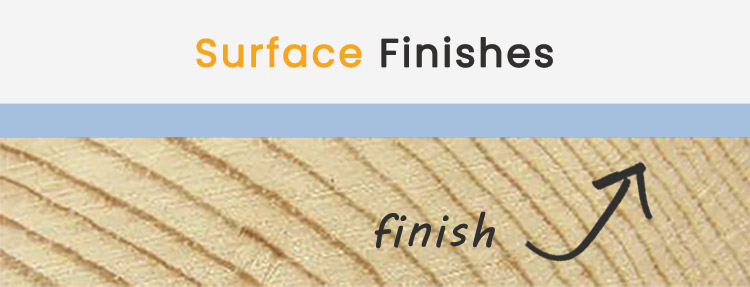
Surface finishes are very popular because they are durable, water-resistant and need very little maintenance.
These finishes are basically combinations of resins mixed with solvents or water. The solvents or water allow the resins to be fluid. Once the finish is applied the water or solvents evaporate and leave the resin to set up a thin “plastic” film on the surface or the wood. They’re commonly referred to as urethanes or polyurethanes because that is what remains on the surface of the wood to form the protective coating. This creates a protective barrier between the wood floor and the surrounding environment.
When you walk on the floor you are really walking on the finish. As wear occurs on the floor, it’s the finish, not the wood, that’s wearing away. They’re generally available in high-gloss, semi-gloss, satin and matte sheens.
Below you can see a satin oil-based finish on a red oak floor…
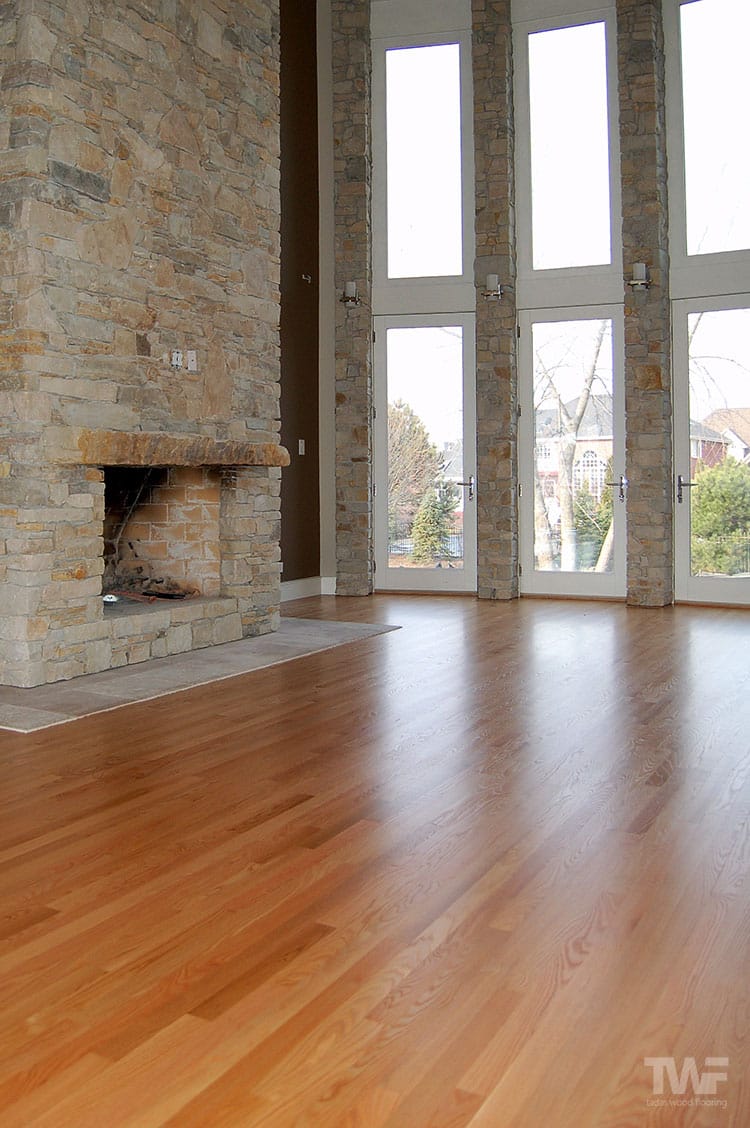
Surface finishes in general are very durable and make cleaning easy, but they can be difficult to repair and patch without refinishing the entire floor.
There are four basic types of surface finishes available for site finished floors:
— Oil Based/Oil Modified Polyurethane
Oil based finish is a solvent based urethane. In the past this was the most common surface finish used in Naperville and the surrounding Chicago areas. It was durable and the wood turned a beautiful rich amber color when it was applied.
Recently the powers to be have begun to outlaw this type of finish because of the high VOC’s (Volatile Organic Compounds). Since then, finish manufacturers have been scrambling trying to come up with new formulas that meet the new low VOC laws and are still usable and durable.
The downside of oil based finish is that it has a somewhat strong solvent smell for quite a few days after application, and it will change color and darken over time when exposed to sunlight.
— Water Based/Waterborne Polyurethane
Water based finishes are polyurethanes, acrylics or a blend of both. They come as either a single or a two component product.
The two component products have a separate catalyst that is added to the finish just prior to use. They are fast drying and the finish is clear when dry. They have far more wear resistance than most oil based finishes. Being water based, they have extremely little odor. There are no solvents released as it cures, only water vapor. They also have the lowest VOC’s among surface finishes.
Two component water based finishes are among the most advanced types of finishes. Every finish manufacturer is putting lots of effort into making these the best finishes available and these finishes are the way of the future. They’re among the most durable finishes as well. They are generally the most resistant to chemicals, scratches and abrasion when compared to other types of commonly used residential finishes.
Of all the finishes, high-end two component water based finishes are the most expensive. Most have the benefit of having built in UV inhibitors so your floor won’t change color anywhere near as fast as it will with an oil based finish.
On the other end of the scale are cheap single component water based polyurethanes (found in big box stores). These are nowhere near as durable as professional systems. These low quality finishes won’t last as long and are affected by UV much quicker.
— Moisture Cured Urethane
Moisture cure is a solvent based urethane finish. As its name implies, it reacts with moisture in the air to cure.
It’s one of the most durable and moisture resistant finishes available. It’s mainly used on commercial projects. It is extremely difficult to apply, very toxic and has an extremely high amount of fumes and smell. Not many homes have this finish, it’s used more in commercial settings and it’s now banned in many areas because of the very high VOC’s.
— Swedish Finish/Acid Cure
Most commonly referred to as Swedish finish, acid cure is a very durable finish. This finish was quite popular in Naperville and the Chicago area years ago. You may recognize the name Glitsa, this is a Swedish finish. It provides a nice amber color to the wood similar to oil based finishes.
Swedish finish has extremely strong fumes that smell terrible (similar to moisture cure) and comes with a very high VOC level. It will also change color over time and it takes quite a long time to cure.
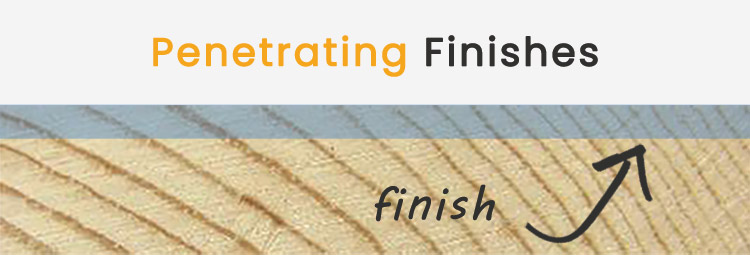
Penetrating finishes, as the name implies, penetrate into the wood pores and then harden to form a protective penetrating seal.
So instead of walking on the finish, like you would with the finishes we talked about above, you are actually walking on the actual wood and it’s the wood that wears down, not the finish. These types of finishes include tung oil, linseed oil and other specialty oils. Most of these oils take a much longer time to dry compared to other finishes.
Penetrating finishes don’t offer a lot of resistance to staining from solvents, water, alcohol, and urine. But on the positive side, most scratches can easily be repaired by simply recoating the affected area.
Another advantage of penetrating finishes is that they are flexible and move with the wood, this can be beneficial especially on softer or wider plank floors and in areas with high swings in humidity like Chicago where wood moves a lot.
Only certain cleaners can be used on the floor with these penetrating oil finishes otherwise they will be ruined.
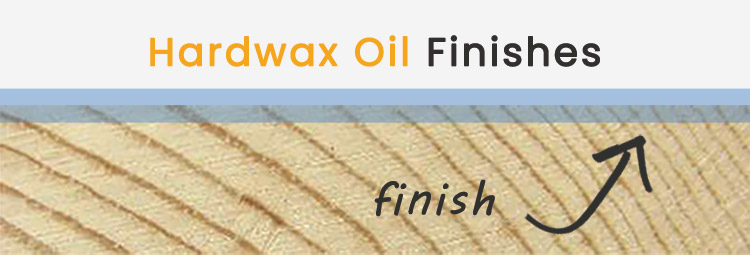
This group of finishes is the new kid on the block. They’ve been around for over a decade now in the States, and longer in Europe (where they originate from). After many years of using them, we have enough real world data and experience with them to be able to talk about and recommend certain ones with confidence.
These finishes are blended from natural, environmentally friendly ingredients like plant oils and waxes.
One of the biggest benefits is that they are extremely low in VOC’s. In fact a few of them have absolutely no VOC’s at all. That’s good for the environment and good for the nose as well. At the very most they will have a cooking oil aroma for a little while as they dry.
Unlike surface finishes that lay on top of the wood and penetrating oils that sink into the pores of the wood, hardwax oils (or hardened oils as some call them) are designed so that they impregnate the pores of the wood and leave a protective surface—although not a hard “plastic” looking or feeling one. The finished product is more like a hand rubbed velvety matte look.
Below is a photo of a hardwax oil finish on a white oak floor…
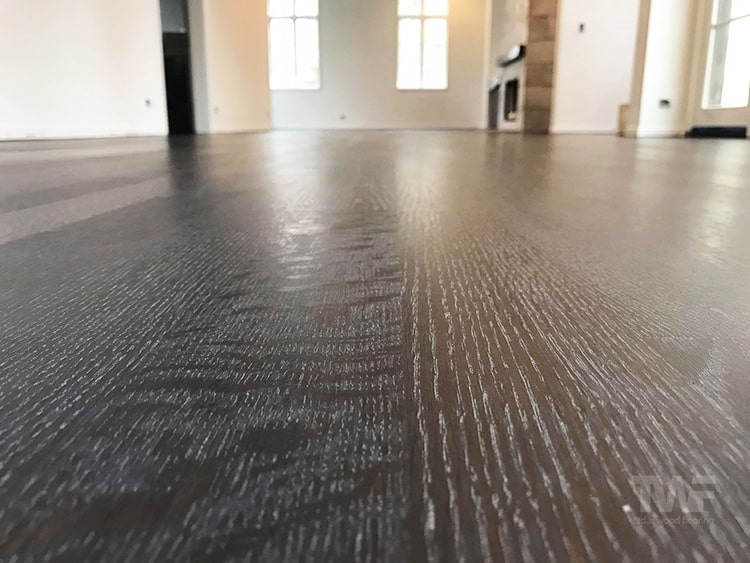
Some hardwax oils are 1 coat systems and others are 2 or 3 coat systems. There’s also the option to add a little sheen with additional steps if you like.
One of the great things about these finishes is that they combine a lot of the benefits of surface and oil finishes and they remove many of the disadvantages. For example, hardwax oils are much easier to spot repair than surface finishes. They don’t have the headache of constant maintenance and waxing like penetrating oils. Plus they don’t stink up the house and drive you out of your home like some finishes will.
We’ve spent quite a bit of time and effort testing them and using them in the real world and we feel there is a very bright future for hardwax oils in the professional refinishing world.
So how do you go about choosing between all of these finishes?
That is the subject of our next blog post in Part 2.
–
Updated Jan 2023

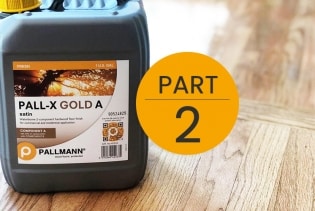

thanks so much for your great advice!
wondering your thoughts on using street shoe brand water finish with dark walnut floors. My contractor wants to use street shoe brand but I also read that this isn’t a good finish for dark stained floors.
…of course he’s starting to stain tomorrow….sorry last minute!
Hi Meg,
You’re welcome, glad to be of help. Street Shoe is a reputable brand of finish you you can rest assured knowing your floors will be fine. And yes satin is a good choice for sheen :)
Hope they turn out well!
Tadas
Hello, what do you think of Duraseal Max water based finish? The flooring company in my area uses all Duraseal products and has suggested this finish for my floors.
Thank you for considering.
Hi Katie,
We don’t use that product and haven’t tried it, but it looks like a good professional option. We use Duraseal stains and are very happy with their performance. Always best to do a test sample and see for yourself though.
Tadas
We have a red oak floor with an Osmo finish. Apart from the fact that we’ve found it patchy and inconsistent in its look, we find it easily absorbs stains. We live in the country in Northern California, have an indoor/outdoor dog and five grandsons ages 6 to 12. There’s a lot of wear and tear. The floor requires a lot of maintenance. Friends praise their Bona floors, but I find them dull in appearance unless they have additional clear coats over them. While we hope to avoid having the floor look like plastic, the idea of a satin finish two-component water base polyurethane is attractive. In rough percentage terms, how much more would we pay compared to going with a Bona or single component urethane finish? Also, how much preparation (screening? sanding?) would be required to go from the Osmo to the two-component polyurethane?
Hi Larry,
It’s very hard for me to give a price as every state and areas have different prices. I would need to see the floors in person as well before advising how to fix them. Best bet would be to get a couple of quotes from the local flooring businesses.
Sorry I couldn’t be more helpful.
Tadas